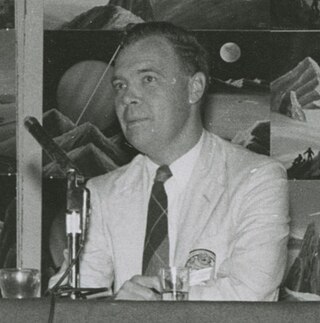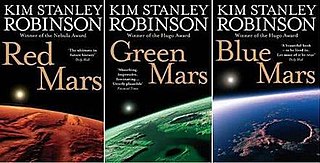
Harry Clement Stubbs, better known by the pen name Hal Clement, was an American science fiction writer and a leader of the hard science fiction subgenre. He also painted astronomically oriented artworks under the name George Richard.

Mars, the fourth planet from the Sun, has appeared as a setting in works of fiction since at least the mid-1600s. Trends in the planet's portrayal have largely been influenced by advances in planetary science. It became the most popular celestial object in fiction in the late 1800s, when it became clear that there was no life on the Moon. The predominant genre depicting Mars at the time was utopian fiction. Around the same time, the mistaken belief that there are canals on Mars emerged and made its way into fiction, popularized by Percival Lowell's speculations of an ancient civilization having constructed them. The War of the Worlds, H. G. Wells's novel about an alien invasion of Earth by sinister Martians, was published in 1897 and went on to have a major influence on the science fiction genre.
The Galactic Empire series is a science fiction sequence of three of Isaac Asimov's earliest novels, and extended by one short story. They are connected by their early place in his published works and chronological placement within his overarching Foundation universe, set around the rise of Asimov's Galactic Empire, between the Robot and Foundation series to which they were linked in Asimov's later novels.

Alien invasion or space invasion is a common feature in science fiction stories and film, in which extraterrestrial lifeforms invade the Earth to exterminate and supplant human life, enslave it, harvest people for food, steal the planet's resources, or destroy the planet altogether. It can be considered as a science-fiction subgenre of the invasion literature, expanded by H. G. Wells's seminal alien invasion novel The War of the Worlds.

The Mars trilogy is a series of science fiction novels by Kim Stanley Robinson that chronicles the settlement and terraforming of the planet Mars through the personal and detailed viewpoints of a wide variety of characters spanning almost two centuries. Ultimately more utopian than dystopian, the story focuses on egalitarian, sociological, and scientific advances made on Mars, while Earth suffers from overpopulation and ecological disaster.

Robert Charles Wilson is an American-Canadian science fiction author.

Stanley Grauman Weinbaum was an American science fiction writer. His first story, "A Martian Odyssey", was published to great acclaim in July 1934; the alien Tweel was arguably the first character to satisfy John W. Campbell's challenge: "Write me a creature who thinks as well as a man, or better than a man, but not like a man." Weinbaum wrote more short stories and a few novels, but died from lung cancer less than a year and a half later.

The Ice Warriors are a fictional extraterrestrial race of reptilian humanoids in the long-running British science fiction television series Doctor Who. They were originally created by Brian Hayles, first appearing in the 1967 serial The Ice Warriors where they encountered the Second Doctor and his companions Jamie and Victoria. In Doctor Who, the Ice Warriors originated on Mars, which within the series narrative is a dying world. Their early appearances depict the Ice Warriors as attempting to conquer the Earth and escape their planet as early as Earth's Ice Age. A frozen group are discovered by an Earth scientific team who dub them 'Ice Warriors' in their first appearance. Despite this not being the name of their species, an Ice Lord later refers to his soldiers as Ice Warriors in the 1974 serial The Monster of Peladon. Similarly there is a fleeting reference to themselves as such in The Curse of Peladon. Although originally appearing as villains, subsequent appearances have depicted Ice Warriors that have eschewed violence and even ally themselves with the Doctor. They have also been featured in flashback and cameo appearances, in addition to appearing frequently in spin-off media such as novels and audio releases.

The planet Venus has been used as a setting in fiction since before the 19th century. Its impenetrable cloud cover gave science fiction writers free rein to speculate on conditions at its surface—a "cosmic Rorschach test", in the words of science fiction author Stephen L. Gillett. The planet was often depicted as warmer than Earth but still habitable by humans. Depictions of Venus as a lush, verdant paradise, an oceanic planet, or fetid swampland, often inhabited by dinosaur-like beasts or other monsters, became common in early pulp science fiction, particularly between the 1930s and 1950s. Some other stories portrayed it as a desert, or invented more exotic settings. The absence of a common vision resulted in Venus not developing a coherent fictional mythology, in contrast to the image of Mars in fiction.

Alexander Petrovich Kazantsev was a popular Soviet and Russian science fiction writer, ufologist and chess composer.

"A Martian Odyssey" is a science fiction short story by American writer Stanley G. Weinbaum originally published in the July 1934 issue of Wonder Stories. It was Weinbaum's second published story, and remains his best known. It was followed four months later by a sequel, "Valley of Dreams". These are the only stories by Weinbaum set on Mars.

Spin is a science fiction novel by American-Canadian writer Robert Charles Wilson. It was published in 2005 and won the Hugo Award for Best Novel in 2006. It is the first book in the Spin trilogy, with Axis published in 2007 and Vortex published in July 2011.
The fictional portrayal of the Solar System has often included planets, moons, and other celestial objects which do not actually exist in reality. Some of these objects were, at one time, seriously considered as hypothetical planets which were either thought to have been observed, or were hypothesized to be orbiting the Sun in order to explain certain celestial phenomena. Often such objects continued to be used in literature long after the hypotheses upon which they were based had been abandoned.
The 20th World Science Fiction Convention (Worldcon), also known unofficially as Chicon III, was held on 31 August–3 September 1962 at the Pick-Congress Hotel in Chicago, Illinois, United States.

In the Courts of the Crimson Kings is a 2008 alternate history science fiction novel by American writer S. M. Stirling.

Vortex is a science fiction novel by American-Canadian writer Robert Charles Wilson, published in July 2011. It is the third book in the Spin series, following the Hugo Award-winning Spin and Axis.

The War of the Worlds is a science fiction novel by English author H. G. Wells. It was written between 1895 and 1897, and serialised in Pearson's Magazine in the UK and Cosmopolitan magazine in the US in 1897. The full novel was first published in hardcover in 1898 by William Heinemann. The War of the Worlds is one of the earliest stories to detail a conflict between humankind and an extraterrestrial race. The novel is the first-person narrative of an unnamed protagonist in Surrey and his younger brother in London as southern England is invaded by Martians and is one of the most commented-on works in the science fiction canon.

The Martian is a 2011 science fiction debut novel written by Andy Weir. The book was originally self-published on Weir's blog, in a serialized format. In 2014, the book was re-released after Crown Publishing Group purchased the exclusive publishing rights. The story follows an American astronaut, Mark Watney, as he becomes stranded alone on Mars in 2035 and must improvise in order to survive.
Speculative evolution is a subgenre of science fiction and an artistic movement focused on hypothetical scenarios in the evolution of life, and a significant form of fictional biology. It is also known as speculative biology and it is referred to as speculative zoology in regards to hypothetical animals. Works incorporating speculative evolution may have entirely conceptual species that evolve on a planet other than Earth, or they may be an alternate history focused on an alternate evolution of terrestrial life. Speculative evolution is often considered hard science fiction because of its strong connection to and basis in science, particularly biology.
This is an incomplete list of works by American space opera and science fiction author Frederik Pohl, including co-authored works.














